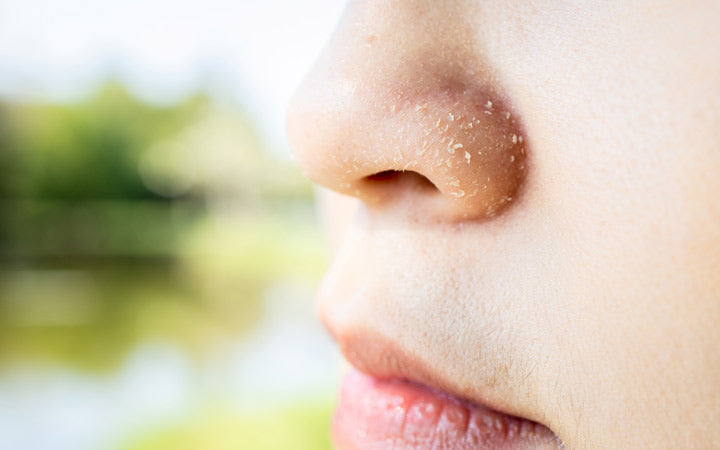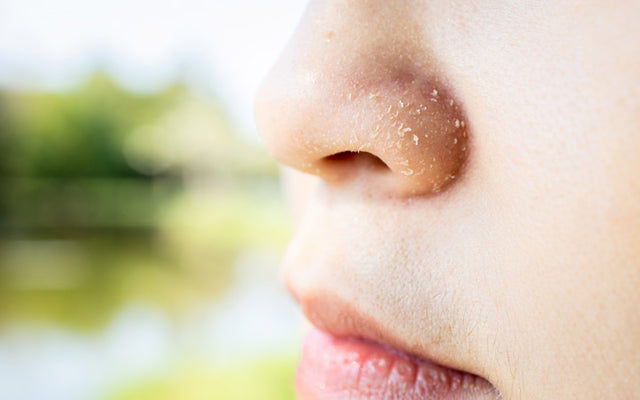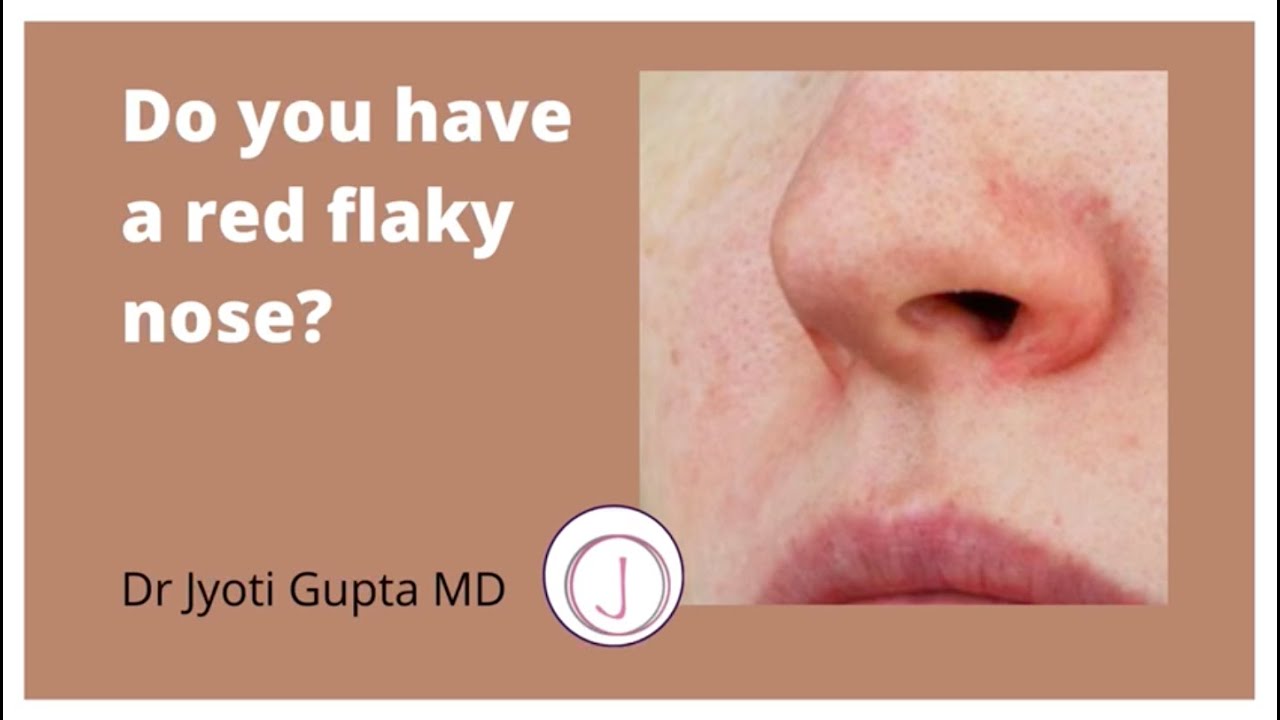To treat dry skin around the nose, moisturize daily and use a gentle exfoliant. Avoid harsh skincare products.
Dry skin around the nose can be uncomfortable and unsightly. It often results from environmental factors, allergies, or harsh skincare products. Proper hydration and gentle care are essential to address this issue effectively. Use a moisturizer specifically designed for sensitive skin to maintain hydration.
Incorporate a mild exfoliant to remove dead skin cells and allow better absorption of moisturizing products. It’s crucial to avoid products with alcohol or fragrances, as they can further irritate the skin. Drinking plenty of water and maintaining a balanced diet also supports skin health. By adopting these practices, you can effectively manage and prevent dry skin around your nose.
Causes Of Dry Skin Around Nose
Dry skin around the nose can be uncomfortable and unsightly. Understanding its causes helps in effective treatment. Here are the primary causes:
Environmental Factors
Environmental factors play a significant role in drying out the skin. Cold weather is one of the main culprits. During winter, the air lacks humidity. This causes the skin to lose moisture quickly. Indoor heating also dries out the air. This further aggravates the condition.
Exposure to strong winds can strip the skin of its natural oils. This leads to dryness and irritation. Excessive sun exposure is another factor. The sun’s UV rays damage the skin’s barrier. This makes it less effective at retaining moisture.
Medical Conditions
Certain medical conditions can cause dry skin around the nose. One common condition is eczema. Eczema causes the skin to become red, itchy, and dry. It often affects areas around the nose.
Psoriasis is another condition that can lead to dry skin. Psoriasis causes the skin cells to multiply rapidly. This results in thick, scaly patches that can be very dry.
Allergic reactions can also cause dryness. Allergies to certain skincare products can irritate the skin. This leads to dryness and flakiness.
Dehydration is another medical factor. When the body lacks water, the skin becomes dry and less elastic.
| Factor | Effect on Skin |
|---|---|
| Cold Weather | Reduces skin moisture |
| Strong Winds | Strips natural oils |
| Sun Exposure | Damages skin barrier |
| Eczema | Causes redness and dryness |
| Psoriasis | Creates thick, dry patches |
| Allergic Reactions | Leads to irritation and dryness |
| Dehydration | Makes skin less elastic |
Symptoms To Watch For
Dry skin around the nose can be uncomfortable and unsightly. It’s important to recognize the symptoms early. Knowing what to look for can help you treat it effectively.
Redness And Irritation
One common symptom of dry skin around the nose is redness. The skin may appear flushed or pink. This redness can be persistent. It often becomes more noticeable after washing your face.
Irritation is another sign. The skin may feel itchy or sore. Small bumps can develop, causing further discomfort. Touching or scratching the area can make it worse.
Flaking And Peeling
Another symptom to watch for is flaking. You might notice small white flakes of skin. These flakes can fall off easily, especially after applying makeup.
Peeling is also common. The skin around your nose may start to peel in small patches. This can make the area look uneven and rough.
| Symptom | Description |
|---|---|
| Redness | Flushed or pink skin |
| Irritation | Itchy or sore skin |
| Flaking | Small white flakes |
| Peeling | Skin peeling in small patches |
Recognizing these symptoms can help you take steps to treat dry skin. Early treatment can prevent the condition from worsening.
Daily Skincare Routine
Dry skin around the nose can be uncomfortable and unsightly. A daily skincare routine can help manage and treat this issue. Consistency is key to keeping your skin healthy and hydrated.
Gentle Cleansing
Start with a gentle cleanser to remove dirt and oil. Avoid harsh soaps that can strip your skin of natural oils.
- Choose a fragrance-free cleanser.
- Use lukewarm water for washing your face.
- Pat your face dry with a soft towel.
Moisturizing Techniques
After cleansing, apply a hydrating moisturizer to your skin. This helps lock in moisture and prevent dryness.
- Use a moisturizer with hyaluronic acid or glycerin.
- Apply moisturizer while your skin is still damp.
- Consider using a thicker cream at night.
Avoid products with alcohol, as they can dry your skin further. Look for ingredients like ceramides and niacinamide that help repair the skin barrier.
| Product Type | Recommended Ingredients |
|---|---|
| Cleanser | Fragrance-free, mild surfactants |
| Moisturizer | Hyaluronic acid, glycerin, ceramides |
| Night Cream | Thicker formulation, niacinamide |
These steps can help reduce dryness and keep your skin around the nose healthy.

Credit: skinkraft.com
Natural Remedies
Dry skin around the nose can be irritating and uncomfortable. Natural remedies can offer relief and help restore moisture. These remedies are gentle and effective for all skin types. Let’s explore some easy-to-use natural options.
Aloe Vera Gel
Aloe Vera Gel is a soothing and hydrating remedy. It contains vitamins, minerals, and enzymes that nourish the skin. Here’s how to use it:
- Extract fresh aloe vera gel from a leaf.
- Apply a small amount to the dry skin around your nose.
- Leave it on for 15-20 minutes.
- Rinse with lukewarm water and pat dry.
Use this remedy twice daily for best results. Aloe vera helps reduce inflammation and keeps skin hydrated.
Coconut Oil
Coconut Oil is a natural moisturizer rich in fatty acids. It helps lock in moisture and repair the skin barrier. To use coconut oil:
- Take a small amount of virgin coconut oil.
- Warm it between your palms.
- Gently massage it into the dry skin around your nose.
- Leave it on overnight for deep hydration.
Repeat this process every night. Coconut oil also has antimicrobial properties, protecting your skin from infections.
| Remedy | Benefits |
|---|---|
| Aloe Vera Gel | Soothes, hydrates, reduces inflammation |
| Coconut Oil | Moisturizes, repairs, antimicrobial |
These natural remedies can help you treat dry skin around the nose. Consistent use will ensure soft and hydrated skin.
Over-the-counter Treatments
Treating dry skin around the nose can be simple with over-the-counter treatments. These products are easy to find and use at home. They help keep your skin smooth and hydrated.
Hydrocortisone Cream
Hydrocortisone cream is a popular choice for reducing inflammation. It can soothe irritated skin around the nose. Use a small amount once or twice a day. Do not use it for more than one week without asking a doctor.
| Brand | Strength | Usage |
|---|---|---|
| Cortizone 10 | 1% | Apply twice daily |
| Hydrocortisone Maximum Strength | 1% | Apply once daily |
Ceramide-based Moisturizers
Ceramide-based moisturizers are another great option. These products help restore the skin barrier. They lock in moisture and prevent dryness. Apply these moisturizers after washing your face.
- Look for products with ceramides and hyaluronic acid.
- Brands like CeraVe and Eucerin are highly recommended.
- Use them in the morning and before bed.
Here are some tips for using these moisturizers:
- Wash your face with a gentle cleanser.
- Pat your skin dry with a soft towel.
- Apply the ceramide-based moisturizer evenly around your nose.

Credit: skinkraft.com
Diet And Hydration
Good skin health starts from the inside. Diet and hydration play a crucial role. Eating the right foods and drinking enough water can treat dry skin around the nose. Let’s explore the best options.
Nutrient-rich Foods
Eating foods rich in vitamins and minerals helps keep your skin hydrated.
- Vitamin A: Found in carrots, sweet potatoes, and spinach.
- Vitamin C: Present in oranges, strawberries, and bell peppers.
- Omega-3 Fatty Acids: Available in salmon, walnuts, and flaxseeds.
- Vitamin E: Found in almonds, sunflower seeds, and avocados.
These foods help maintain skin’s moisture and repair damaged cells.
Water Intake
Water is essential for skin hydration. Drink enough water every day.
| Age | Recommended Water Intake |
|---|---|
| Children (9-12 years) | 7-8 cups/day |
| Teenagers (13-18 years) | 8-10 cups/day |
| Adults | 8-12 cups/day |
Water helps to keep your skin soft and supple. It flushes out toxins and supports overall skin health.
Pro Tip: Carry a water bottle to ensure you drink enough.
Combining a healthy diet with proper hydration can significantly improve dry skin around the nose.
When To See A Dermatologist
Experiencing dry skin around the nose can be annoying. Sometimes, basic care isn’t enough. Knowing when to visit a dermatologist is key. Here are some signs you should seek professional help.
Persistent Dryness
If dryness around your nose doesn’t go away, it’s a concern. You may try moisturizers and home remedies. But, if the skin remains flaky and rough, consider seeing a dermatologist.
Persistent dryness can signal underlying issues. It might be eczema or psoriasis. A dermatologist can diagnose the problem accurately. They can prescribe effective treatments.
Severe Inflammation
Redness and swelling around your nose are warning signs. If you experience severe inflammation, your skin needs professional attention. This could indicate an infection or allergic reaction.
Severe inflammation can lead to more serious conditions. A dermatologist will offer the right medication. This can prevent the issue from worsening. Don’t ignore severe symptoms.
| Signs | Possible Conditions |
|---|---|
| Persistent Dryness | Eczema, Psoriasis |
| Severe Inflammation | Infection, Allergy |
In summary, always listen to your skin. If the dryness around your nose persists or worsens, seek professional help. Dermatologists can provide the best care for your skin.
Preventive Measures
Dry skin around the nose can be uncomfortable and unsightly. Taking preventive steps can help keep your skin hydrated and healthy.
Humidifiers
Using a humidifier adds moisture to the air. This helps prevent your skin from drying out. Place a humidifier in your bedroom. This can ensure your skin stays hydrated overnight. Clean the humidifier regularly to avoid mold and bacteria.
Sun Protection
Protecting your skin from the sun is crucial. Use a broad-spectrum sunscreen with SPF 30 or higher. Apply it daily, even on cloudy days. Wear a wide-brimmed hat when you are outside. This provides extra protection for your face.
| Preventive Measure | Action |
|---|---|
| Humidifiers | Add moisture to indoor air |
| Sun Protection | Use sunscreen and wear hats |

Credit: www.reddit.com
Frequently Asked Questions
What Causes Dry Skin Around The Nose?
Dry skin around the nose can be caused by harsh weather, excessive washing, or using irritating skincare products.
How Can I Moisturize Dry Skin?
Use a gentle, hydrating moisturizer. Apply it twice daily, especially after cleansing.
Are There Natural Remedies For Dry Nose Skin?
Yes, you can use aloe vera, coconut oil, or honey to soothe and hydrate dry skin.
Should I Exfoliate Dry Skin Around The Nose?
Exfoliate gently once a week. Use a mild exfoliant to remove dead skin cells without causing irritation.
Conclusion
Achieving smooth skin around the nose is possible with the right care. Hydrate, use gentle products, and avoid harsh exfoliants. Consistency is key for lasting results. Follow these tips to enjoy healthy, moisturized skin. Remember, patience and persistence pay off in skincare.








